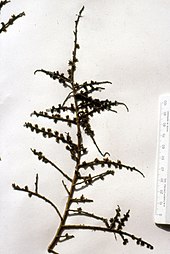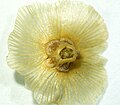Halothamnus somalensis
| Halothamnus somalensis | |
|---|---|

| |
| Scientific classification | |
| Kingdom: | Plantae |
| Clade: | Tracheophytes |
| Clade: | Angiosperms |
| Clade: | Eudicots |
| Order: | Caryophyllales |
| Family: | Amaranthaceae |
| Genus: | Halothamnus |
| Species: | H. somalensis
|
| Binomial name | |
| Halothamnus somalensis | |
| Synonyms | |
| |
Halothamnus somalensis is a species of the plant genus Halothamnus, that is now included into the family Amaranthaceae, (formerly Chenopodiaceae). It is endemic to the Horn of Africa (Djibouti, Somalia, and Ethiopia) and is used for traditional medicine.
Description[edit]
Halothamnus somalensis is a thorny shrub 30–90 cm high, with olive-green branches, that partly turn black when drying. The semiterete, tiny leaves are appressed to the branches, and only 0,5–3 mm long. The flowers are 3,0-4,7 mm long. The winged fruit is 8-12,5 mm in diameter, their wings never turning black even on blackened plants. The bottom of the fruit tube has very small linear grooves located near the periphery, lacking any prominent radial veins.
-
fruit (lateral view)
-
fruit (bottom)
Anatomy[edit]
Halothamnus somalensis has epidermis walls with an outer cutinized layer in addition to the cuticle itself. It is the only species of the genus that shows this anatomical feature.[1]
Taxonomy[edit]
The species has been first described in 1909 by Nicholas Edward Brown as Salsola somalensis (In: Bull. Misc. Inform. 2, 1909, p. 50).[2] In 1981, Victor Petrovič Botschantzev included it into the genus Halothamnus.[3] The species has sometimes been misidentified as Halothamnus bottae, occurring on the Arabian peninsula.
Distribution[edit]
Halothamnus somalensis is endemic in Djibouti, Somalia and dry areas of Ethiopia. Similar plants from the Arabian peninsula belong to Halothamnus bottae ssp. niger.[1] It grows in open thorny savanna on sandy, clayey or rocky ground, from 0–1750 m above sea level.
Uses[edit]
The roots of Halothamnus somalensis are traditionally used as a medicine plant against parasitic worm diseases in animals or humans.[4]
Vernacular names[edit]
In Somalia, the species is known as "gosomadowbeye"[5] ("gowsa-madobeyi", "goso-mudo-weyi", "gusomadobeye", "gosama do beya"[6]) This name derives from the Somalian words goso (= molar teeth) and madow (= black), referring to the fact, that the teeth and lips are stained black when the plant is eaten.[5] Other commons names are "afmadobeye",[5] "dankup",[5] "mirrow",[5] "mimou",[7] or "mirgi-edalis".[6] In Djibouti, the species is called "Yagali".[8]
References[edit]
- Gabriele Kothe-Heinrich: Revision der Gattung Halothamnus (Chenopodiaceae). Bibliotheca Botanica Bd. 143, Schweizerbart, Stuttgart 1993, ISBN 978-3-510-48014-2, p. 49-53 Bibliotheca Botanica Bd. 143
- ^ a b Gabriele Kothe-Heinrich: The genus Halothamnus (Chenopodiaceae) in Southwest Asia. - Flora et Vegetatio Mundi 9, 1991, p.43-52.
- ^ Nicholas Edward Brown: Salsola somalensis N.E.Br. In: Bull. Misc. Inform. 2, 1909, p. 50
- ^ Victor Petrovič Botschantzev: Revisio generis Halothamnus Jaub. et Spach (Chenopodiaceae) (russ.). In: Bot. Mater. Gerb. Bot. Inst. Komarova Akad. Nauk SSSR = Novosti Sistematiki Vysshikh Rastenii. Moscow & Leningrad 18, 1981, p. 151
- ^ F. Dawo & M. Tibbo: Anthelmintic effect of Halothamus somalensis in Arsi-Bale goats. In: Livestock Research for Rural Development. Volume 17, Article #68, 2005.
- ^ a b c d e Entry and herbarium specimen of Halothamnus somalensis at JSTOR
- ^ a b G. Cufodontis: Enumeratio plantarum Aethiopiae. - Bull. Jard. Bot. État 23 (3/4) Suppl., 1953
- ^ Herbarium specimen Hemming 1435 (Herbarium: K ex EA)
- ^ Herbarium specimens Chedeville 75, Chedeville 216 (Herbarium: FT), Denis 79 (Herbarium: P)
External links[edit]
- Halothamnus somalensis with distribution map, at African Plant Database


